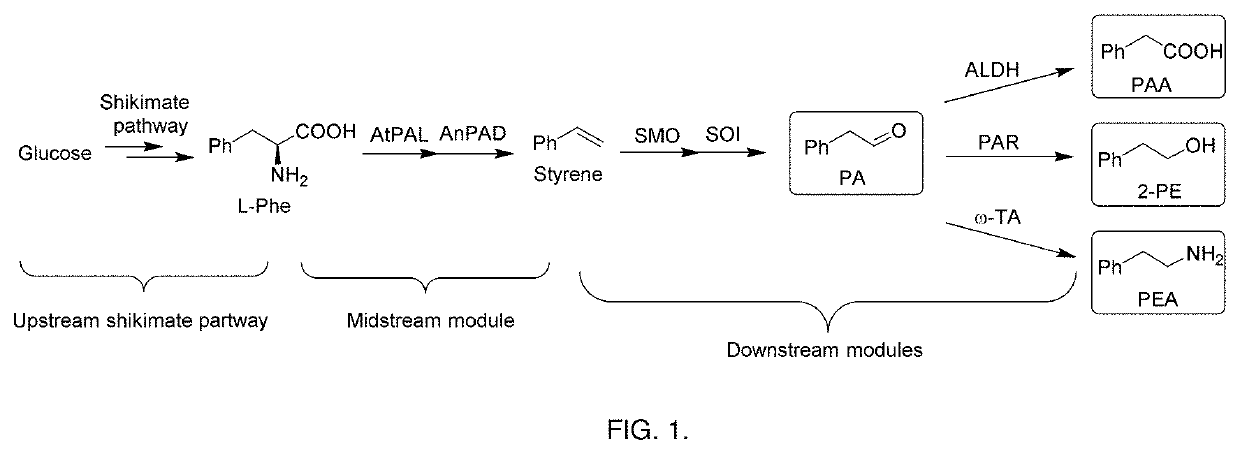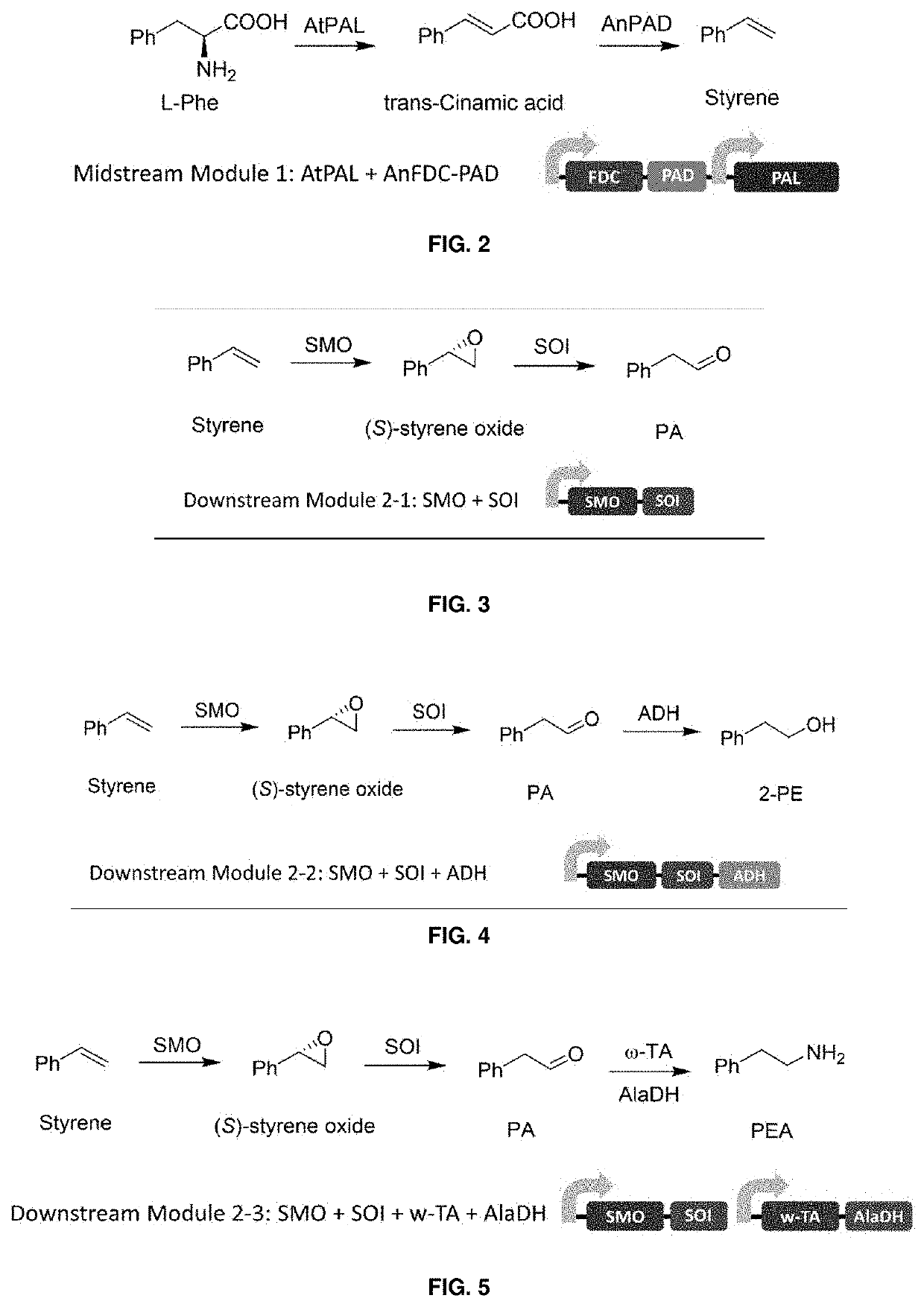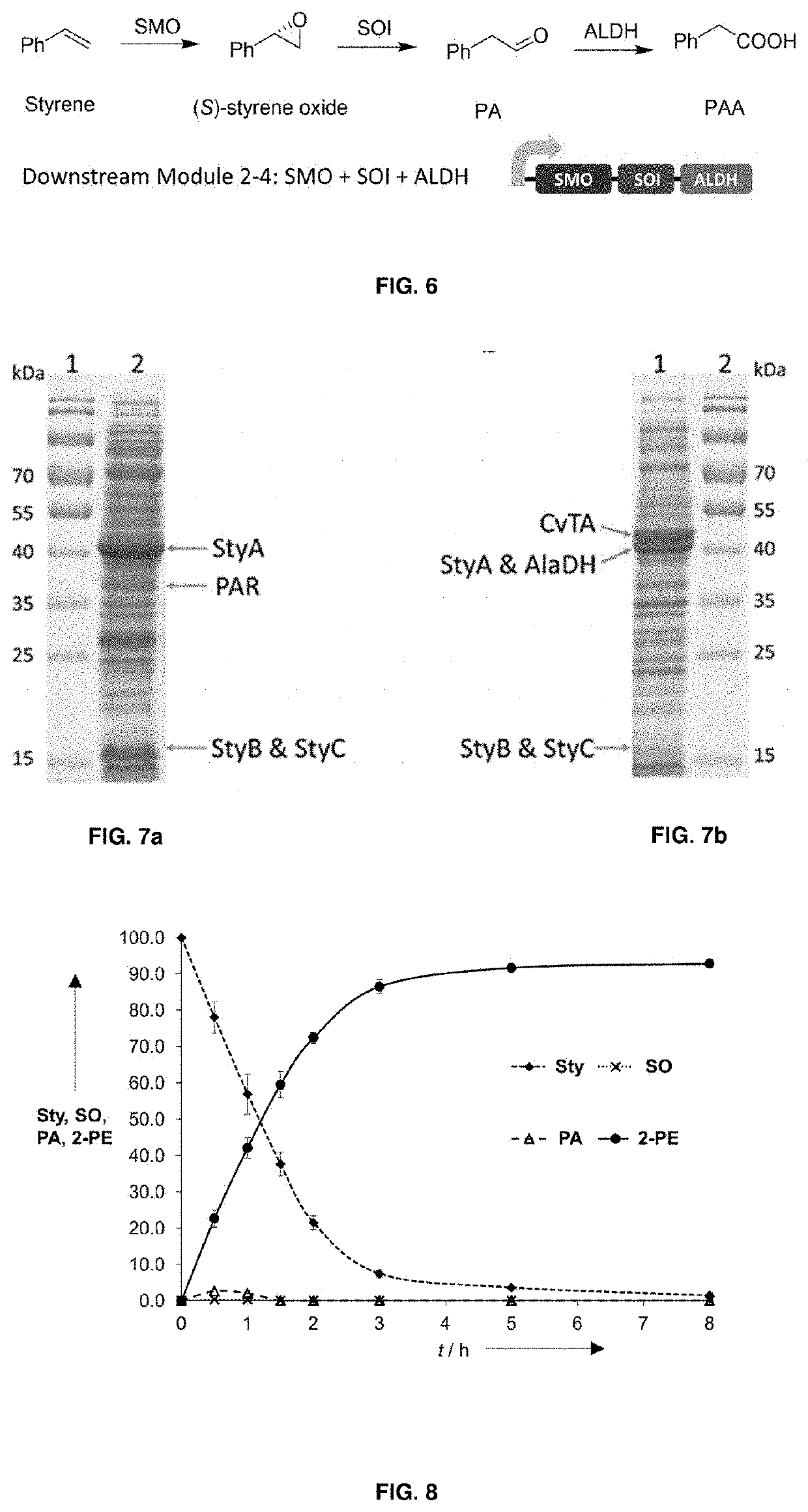Bioproduction of phenethyl alcohol, aldehyde, acid, amine, and related compounds
a technology of phenethyl alcohol and biosynthesis, applied in the direction of lyase, transferase, enzymology, etc., can solve the problems of low efficiency, limited efficiency of existing biosynthesis, and inability to meet the large market demand of botanical sources
- Summary
- Abstract
- Description
- Claims
- Application Information
AI Technical Summary
Benefits of technology
Problems solved by technology
Method used
Image
Examples
example 18.2
Example 18. 2-PE Product Inhibition
[0174]Apart from the achievements that have been reported so far, most of the 2-PE production is hindered by the product toxicity. Concentrations of 2-PE higher than 2-3 gr / L will inhibit the cells, causing a low conversion of the product in the end of the biotransformation. [Etschmann, M., Bluemke, W., et al., J. Appl. Microbiol. Biotechnol. 59: 1-8; (2002); Hua, D., Xu, P. Biotechnol. Adv. 29: 654-660 (2011); Hua, D. L, Liang, X. H., et al., Asian J. Chem. 25(11): 5951-5954 (2013); Stark, D., Zala, D., et al., Enzyme Microb Technol. 32: 212-223 (2003)] 2-PE will aim the cell membrane once it is formed during the biotransformation, hence enlarging the membrane fluidity and deflating both glucose and substrate uptake [Seward, R., Willets, J. C., Dinsdale, M. G., and Lloyd, D. J Inst Brew. 102: 439-443 (1996)]. Protein and RNA inhibitions towards E. coli were also reported before due to the exceeding concentration of 2-PE [Luchini, J. J., Corre, J.,...
example 19
and Selection of Organic Solvent for Partitioning 2-PE
[0178]In-situ product removal technique via extraction have been conducted to remove the obtained 2-PE from the aqueous phase and make its concentration below the inhibitory level. We investigated different type of organic solvents and ionic liquids to perform the extractive biotransformation for 2-PE production via styrene-derived pathway from L-phenylalanine, starting from the analysis of their partition coefficients in the biphasic system. Product and substrate coefficient partitions in organic and aqueous phase were determined by adding different concentration of 2-PE and L-phenylalanine, respectively, into KP buffer (100 mM, pH 8.0) together with the respective organic solvents. Reaction mixtures were incubated for 1 h (280 rpm, 30° C.).
[0179]Results in FIG. 18 (a) show that most of the organic solvents used were able to extract 2-PE from the aqueous phase. It is shown through the K value which is >>>1, which indicated that ...
example 20
n and Characterization of Nano-Solid Adsorbent
[0181]The use of a magnetic adsorbent consisting of iron oxide core and benzene ring functional groups on the surface was investigated. Polystyrene was employed to coat the OA-MNP in order to protect the iron oxide cores.
[0182]The synthesis of the OA-MNP-PS is shown in FIG. 19a. The OA-MNP and OA-MNP-PS were found to have a diameter of 12 nm and 118 nm, respectively, as well as a hydrodynamic size of 23 nm and 180 nm, respectively (FIGS. 19c and 19e). Separation was done by magnetic force or centrifugation (30 min, 13 000 g). The investigation was performed by analysing the product adsorption towards the synthesized MNP through the hydrophobic interactions.
PUM
| Property | Measurement | Unit |
|---|---|---|
| Temperature | aaaaa | aaaaa |
| Molar density | aaaaa | aaaaa |
| Molar density | aaaaa | aaaaa |
Abstract
Description
Claims
Application Information
 Login to View More
Login to View More - R&D
- Intellectual Property
- Life Sciences
- Materials
- Tech Scout
- Unparalleled Data Quality
- Higher Quality Content
- 60% Fewer Hallucinations
Browse by: Latest US Patents, China's latest patents, Technical Efficacy Thesaurus, Application Domain, Technology Topic, Popular Technical Reports.
© 2025 PatSnap. All rights reserved.Legal|Privacy policy|Modern Slavery Act Transparency Statement|Sitemap|About US| Contact US: help@patsnap.com



